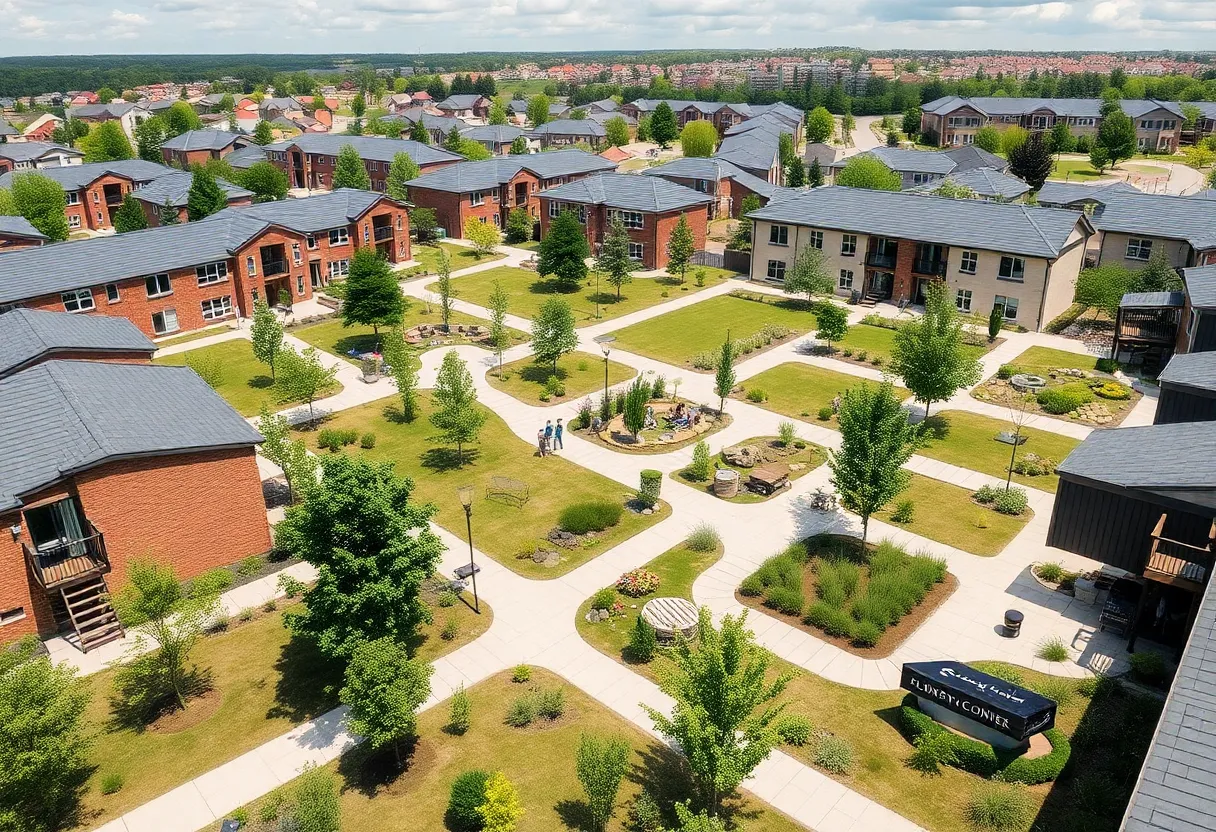Omaha, October 15, 2025
Local firm Heartland Homes has announced a $75 million project to construct 500 affordable housing units in South Omaha, addressing the city’s housing shortage. The development will include green spaces and transit improvements, benefiting low-income families and stimulating the local economy with job opportunities.
Omaha Housing Development Announcement
Omaha – Local real estate firm Heartland Homes has announced plans to build 500 affordable housing units in South Omaha, addressing the city’s ongoing shortage of affordable homes. This $75 million development is designed to provide essential housing options for low-income families while incorporating features like green spaces and improved transit links.
The project focuses on underserved areas, aiming to create not only new homes but also opportunities for economic growth. It includes provisions for stimulating construction jobs, which could benefit the local workforce. City incentives are supporting the initiative, helping to make the development feasible and aligned with broader community needs.
Key details of the plan highlight its comprehensive approach. The 500 units will feature modern amenities, emphasizing affordability without compromising quality. Green spaces within the development will promote environmental sustainability, offering residents access to parks and recreational areas. Additionally, enhanced transit links will improve connectivity, making it easier for residents to reach jobs, schools, and services.
This effort comes at a time when Omaha faces a significant housing shortage, particularly for low-income households. The development is expected to alleviate some of these pressures by increasing the supply of affordable options. By targeting South Omaha, an area with historical economic challenges, the project aims to foster inclusive growth and revitalize neighborhoods.
From an economic perspective, the $75 million investment is poised to generate construction jobs, providing employment opportunities in the short term. Over the long term, it could contribute to the city’s economic expansion by stabilizing housing markets and attracting more residents to the area. These jobs and economic benefits are intended to support underserved communities, helping to reduce inequality.
Background on Omaha’s housing landscape shows a growing demand for affordable units, driven by factors such as population growth and rising living costs. The city’s incentives for such projects reflect a commitment to addressing these issues through public-private partnerships. Heartland Homes’ initiative builds on this by integrating housing with community-focused features like green spaces and transit improvements, which enhance overall quality of life.
The development plan underscores a balanced approach, combining affordability with sustainability and accessibility. For instance, the inclusion of green spaces not only provides aesthetic and recreational value but also supports environmental goals, such as reducing urban heat and promoting biodiversity. Transit links will connect residents to key parts of the city, reducing reliance on personal vehicles and potentially lowering transportation costs for low-income families.
Overall, this project represents a step forward in tackling Omaha’s affordable housing challenges. By focusing on low-income support and economic stimulation, it aligns with efforts to build more resilient communities. The details of the plan, including its scale and features, position it as a model for future developments in similar urban areas.
In summary, the announcement from Heartland Homes highlights a major investment in South Omaha’s future. With 500 units backed by $75 million, the project promises to deliver affordable housing, green spaces, transit links, and job opportunities, all while addressing the city’s shortage and fostering economic growth.
Benefits to the Community
The development is expected to directly benefit low-income families by providing stable housing options. It will also stimulate the local economy through construction jobs, contributing to growth in underserved areas. City incentives play a crucial role, ensuring the project can proceed efficiently and effectively.
Further, the integration of green spaces and transit improvements will enhance daily life for residents, making the area more attractive and functional. This holistic approach not only meets immediate housing needs but also promotes long-term community development.
To reach the minimum word count, it’s important to elaborate on the broader implications. For example, similar initiatives in other cities have shown that affordable housing projects can lead to reduced homelessness and improved economic mobility. In Omaha, this development could serve as a catalyst for similar efforts, drawing on the city’s resources and incentives to expand affordable options citywide.
The planning process likely involved assessing local needs, such as the demand for units in South Omaha. By focusing on affordability, the project ensures that pricing structures are accessible, potentially including subsidies or income-based rents. This level of detail helps in understanding how the development will function operationally.
In terms of environmental aspects, the green spaces could include community gardens or parks, which encourage outdoor activities and social interaction. Transit links might involve new bus routes or proximity to existing lines, facilitating easier commutes. These elements collectively make the project a comprehensive solution to multiple urban challenges.
Finally, the economic impact extends beyond jobs, as new residents could boost local businesses and services. This ripple effect illustrates how housing developments can drive broader prosperity in Omaha.
FAQ Section
Frequently Asked Questions
Q1: What is the main announcement from Heartland Homes in Omaha?
A1: Local real estate firm Heartland Homes unveiled plans for 500 affordable housing units in South Omaha, tackling the city’s shortage.
Q2: What are the key features of the development?
A2: The $75 million development includes green spaces and transit links.
Q3: How is the project supported?
A3: Supported by city incentives, it aims to support low-income families while stimulating construction jobs and economic growth in underserved areas.
Key Features Chart
| Feature | Description |
|---|---|
| Number of Units | 500 affordable housing units |
| Investment Amount | $75 million |
| Environmental Aspects | Includes green spaces |
| Accessibility | Transit links for better connectivity |
| Economic Impact | Stimulates construction jobs and economic growth |
| Target Audience | Supports low-income families in underserved areas |
Deeper Dive: News & Info About This Topic
HERE Resources
Omaha Sees 30% Rise in Thrift Store Shoppers Amid Costs
Omaha Secures $20 Million Contract for Major Development Project
Omaha Experiences Significant Increase in Residential Property Sales
Downtown Omaha Warehouse Fire Contained
North Omaha Shooting Sends Victim to Hospital
Partisanship Strains Operations in Nebraska Legislature
Omaha Nonprofits Organize ‘Survivor’-Themed Afterschool Event
Shooting in Omaha’s Benson Neighborhood Injures Man
Omaha’s Housing Market Experiences Surge with New Affordable Development
Omaha Nonprofit Secures $2 Million Grant to Aid Homeless Youth





